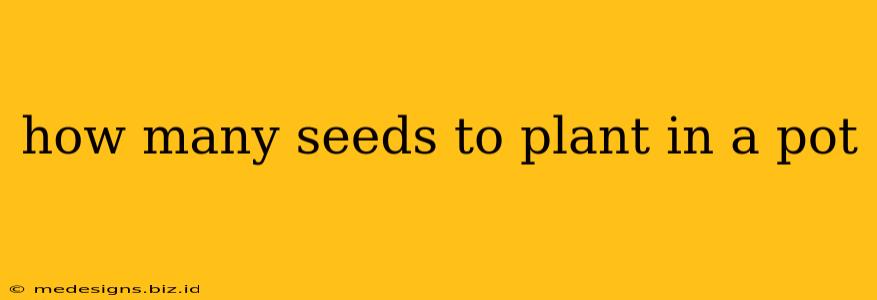How Many Seeds to Plant Per Pot: A Gardener's Guide
So, you're ready to start sowing seeds and nurture your seedlings into thriving plants. But one crucial question often pops up: how many seeds should I plant in each pot? The answer isn't a simple one-size-fits-all, but this guide will help you determine the optimal number based on several factors.
Factors Affecting Seed Density in Pots
Several key factors influence how many seeds you should plant in a single container. These include:
-
Seed Size and Germination Rate: Tiny seeds like lettuce or alyssum have a higher germination rate, meaning more seeds might sprout. Larger seeds, like beans or sunflowers, need more space to grow and often have lower germination rates.
-
Plant Size at Maturity: A sprawling tomato plant will need significantly more space than a compact basil plant. Consider the ultimate size of your plants to avoid overcrowding.
-
Pot Size: This is crucial! A small pot (e.g., 4 inches) can only accommodate one or two seedlings of most plants, while larger containers (e.g., 10 inches or larger) might allow for more.
-
Plant Type: Some plants are better suited to being thinned later (like carrots or lettuce), while others (like peppers or tomatoes) are best started individually.
A Seed-by-Seed Approach: Examples & Guidelines
Let's break down the ideal seed count for some common plants:
1. Small Plants (Lettuce, Herbs, Flowers):
- Small pots (4-6 inches): 2-3 seeds
- Larger pots (8-10 inches): 3-5 seeds
Rationale: These plants tend to grow relatively compact and can tolerate some thinning if multiple germinate.
2. Medium-Sized Plants (Tomatoes, Peppers, Eggplants):
- Individual pots (4-6 inches): 1 seed per pot
- Larger pots (8-10 inches): 1-2 seeds (with space to thin later)
Rationale: These plants need sufficient space to develop strong root systems and prevent overcrowding.
3. Large Plants (Squash, Cucumbers, Melons):
- Large pots (12 inches or larger): 1-2 seeds per pot
Rationale: These vigorous growers require significant space for their extensive root systems and mature size.
The Art of Thinning Seedlings
Even with careful planning, multiple seeds may germinate. Thinning involves removing weaker or overcrowded seedlings to allow the strongest ones to thrive. Thinning is crucial for:
- Improved Air Circulation: Prevents fungal diseases.
- Better Root Development: Allows for robust root growth.
- Increased Yield: Provides more resources to the remaining plants.
To thin, carefully pull out the smaller or less vigorous seedlings, leaving sufficient space between the remaining ones. Don't just yank them; gently loosen the soil around the base of the unwanted plants before removing them to avoid disturbing the roots of the stronger seedlings.
Choosing the Right Pots & Soil for Success
Beyond seed count, selecting the appropriate pot size and quality potting mix are essential for optimal growth. Ensure your pots have adequate drainage holes to prevent waterlogging and use a well-draining potting mix rich in organic matter.
Ultimately, the "how many seeds" question depends on many variables. Use this guide as a starting point and observe your seedlings' growth to adjust your approach as needed. Happy planting!
